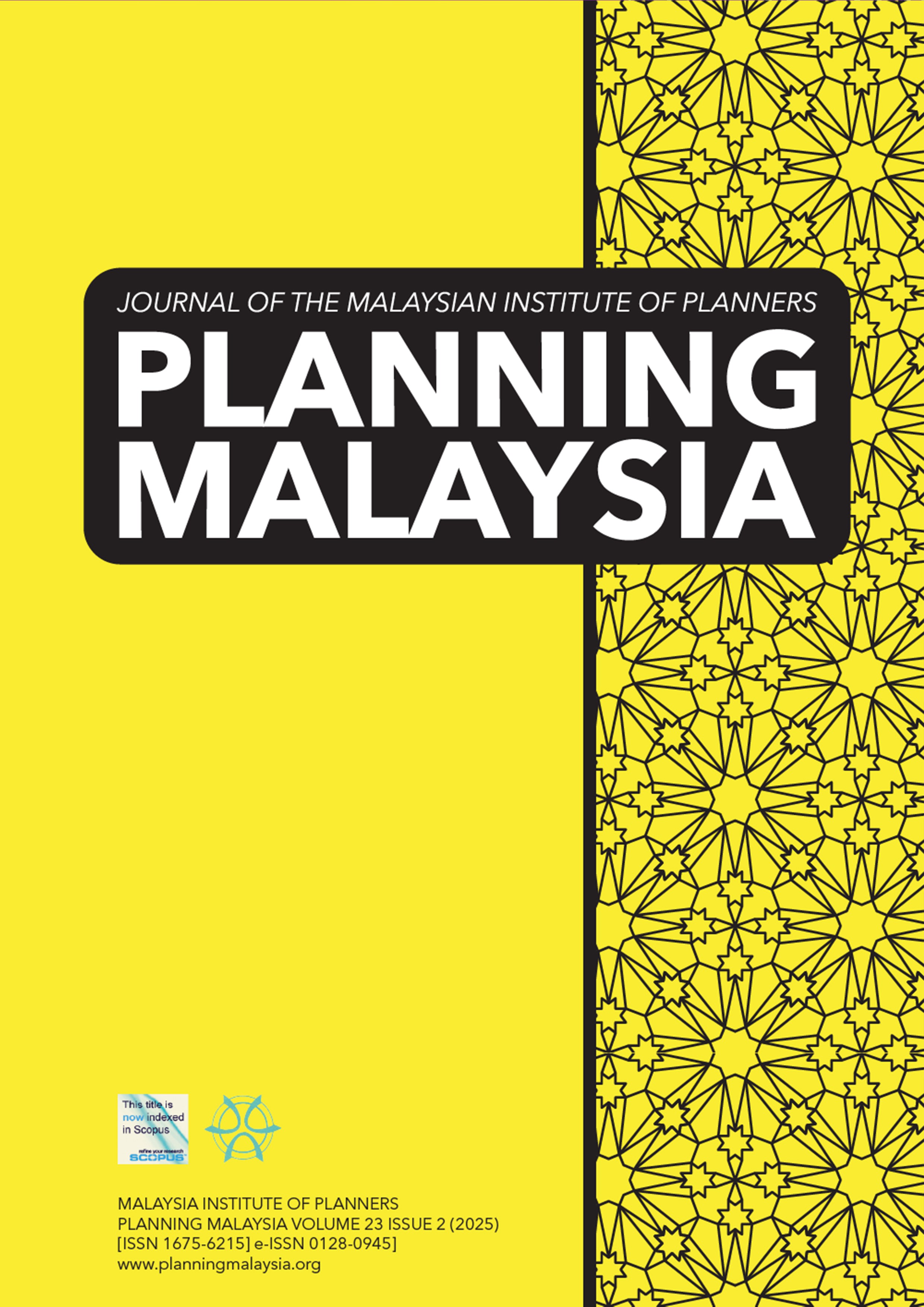URBAN SPRAWL TRANSITION RULE ALGORITHM CONCEPT IN CELLULAR AUTOMATA FRAMEWORK: CASE STUDY OF MALALAYANG DISTRICT, MANADO CITY, INDONESIA
DOI:
https://doi.org/10.21837/pm.v23i36.1725Keywords:
Urban Sprawl, Transition Rule Algorithm, Cellular Automata, Built-up LandAbstract
This study aimed to develop an urban sprawl model transition rule algorithm based on land coverage indicators in a cellular automata grid framework. This study attempts to identify various attributes that impact land coverage in a spatial grid cell using statistical and spatial analysis methods. This concept provides a theoretical and methodological basis for developing a more comprehensive urban sprawl simulation model. The results indicated three determinant factors for the condition of land coverage in a cellular automata spatial grid cell: built-up land conditions, slope gradients, and the availability of road network infrastructure. The concept of the algorithm found can be expressed through the following statements: 1) built-up land in a particular spatial grid will be influenced by the condition of built-up land in neighboring grid cells, with a determination of 67%; 2) every one unit increase in the average area of built-up land in neighboring cells will be associated with the same phenomenon in a particular grid cell of 1.08 units; 3) built-up land on each spatial grid is correlated with the slope gradient and the availability of road network infrastructure on the spatial grid; 4) the flatter the slope condition of a spatial grid will be associated with higher built-up land in the spatial grid cell; and 5) the better the road infrastructure availability on a particular spatial grid will be associated with higher built-up land.
Downloads
References
Angel, S., Parent, J., & Civco, D. (2007). Urban Sprawl Metrics: An Analysis of Global Urban Expansion Using GIS. ASPRS 2007 Annual Conference Tampa, Florida.
Balzter, H., Braun, P. W., & Kohler, W. (1998). Cellular Automata Models for Vegetation Dynamics. Ecological Modelling, 107(2-3), 113–125. DOI: https://doi.org/10.1016/S0304-3800(97)00202-0
Bambulu, V. J., Tondobala, L., & Takumansang, E. D. (2018). Analisis Karakteristik Urban Sprawl di Kota Manado. Jurnal Spasial : Perencanaan Wilayah & Kota, 5(3), 367-376.
Basse, R. M. (2013). A Constrained Cellular Automata Model to Simulate the Potential Effects of High-Speed Train Stations on Land-use Dynamics in Trans-Border Regions, Journal of Transport Geography, 32, 23-37. DOI: https://doi.org/10.1016/j.jtrangeo.2013.08.005
Batty, M., & Xie, Y. (1994). From Cells to Cities. Environment and Planning B: Planning & Design, 21(7), S31-S48. https://doi.org/10.1068/b21S031 DOI: https://doi.org/10.1068/b21S031
Batty, M., Xie, Y., & Sun, Z. (1999). Modeling Urban Dynamics through GIS-based Cellular Automata, Computers, Environment & Urban Systems, 23(3), 205-233. DOI: https://doi.org/10.1016/S0198-9715(99)00015-0
Benedict, M. A., & McMahon, E. T. (2006). Green Infrastructure: Linking Landscapes & Communities. Island Press.
Bento, A. M., Franco, S. F., & Kaffine, D. (2006). The Efficiency and Distributional Impacts of Alternative Anti-Sprawl Policies. Journal of Urban Economics, 59(1), 121-141. DOI: https://doi.org/10.1016/j.jue.2005.09.004
Brueckner, J. K. (2000). Urban Sprawl: Diagnosis and Remedies. International Regional Science Review, 23(2), 160-171. https://doi.org/10.1177/016001700761012710 DOI: https://doi.org/10.1177/016001700761012710
Burchell, R. W., & Mukherji, S. (2003). Conventional Development Versus Managed Growth: The Costs of Sprawl. American Journal of Public Health, 93(9), 1534-1540. https://doi.org/10.2105/AJPH.93.9.1534 DOI: https://doi.org/10.2105/AJPH.93.9.1534
Burchfield, M., Overman, H., Puga, D., & Turner, M. (2005). Causes of Sprawl: A Portrait From Space. Quarterly Journal of Economics, 121(2), 587-633. DOI: https://doi.org/10.1162/qjec.2006.121.2.587
Cao, M., Tang, G., Shen, Q., & Wang, Y. (2015). A New Discovery of Transition Rules for Cellular Automata by Using Cuckoo Search Algorithm. International Journal of Geographical Information Science, 29(5), 806-824. https://doi.org/10.1080/13658816.2014.999245 DOI: https://doi.org/10.1080/13658816.2014.999245
Ewing, R., & Cervero, R. (2010). Travel and the Built Environment: A Meta-Analysis. Journal of the American Planning Association, 76(3), 265–294. https://doi.org/10.1080/01944361003766766 DOI: https://doi.org/10.1080/01944361003766766
Ewing, R., & Rong, F. (2008). The Impact of Urban Form on U.S. Residential Energy Use, Housing Policy Debate, Taylor & Francis Journals, 19(1), 1-30. DOI: https://doi.org/10.1080/10511482.2008.9521624
Hasse, J., & Lathrop, R. G. (2003). A Housing Unit Level Approach to Characterizing Residential Sprawl. Photogrammetric Engineering & Remote Sensing, 69(9), 1021-1030. DOI: https://doi.org/10.14358/PERS.69.9.1021
Pinto, N., Antunes, A. P., & Roca, J. (2021). A Cellular Automata Model for Integrated Simulation of Land Use and Transport Interactions. ISPRS International Journal Geo-Information, 10(3), 149. DOI: https://doi.org/10.3390/ijgi10030149
Rogi, O. H. A., Waani, J. O., & Supardjo, S. (2024). Understanding The Consequences of a City’s Spatial Structure through its Density Profile as Indicator. A Case Study in Manado Municipal, North Sulawesi, Indonesia. Devotion: Journal of Research and Community Service, 5(2), 244-257. DOI: https://doi.org/10.59188/devotion.v5i2.688
Seipalla, B., Latupapua, L., & Lelloltery, H. (2020). Kajian Potensi Ekowisata di Desa Liliboy Kecamatan Leihitu Barat Kabupaten Maluku Tengah. Jurnal Hutan Tropis, 8(3), 280. DOI: https://doi.org/10.20527/jht.v8i3.9627
Soetomo, Soegiono. (2013). Urbanisasi dan Morfologi. Proses Perkembangan Peradaban dan Wadah Ruang. Menuju Ruang yang Manusiawi. Edisi 2. Graha Ilmu.
Sudhira, H. S., Ramachandra, T. V., & Jagadish, K. S. (2012). Urban Sprawl and Its Impact on Land Use and Water Bodies in Bangalore. Applied Geography, 34, 597-606.
Tan, P. L., & Sia, A. (2019). Urban Sprawl and Its Impact on Open Space in Singapore. Sustainability, 11(12), 3280. https://www.mdpi.com/2071-1050/11/12/3280 DOI: https://doi.org/10.3390/su11123280
Tilaar, S., Sela, R. L., & Tondobala, L. (2017). Analisis Urban Compactness Kota Manado. Jurnal Spasial: Perencanaan Wilayah & Kota, 4(2), 116-122.
Tsai, Y. (2005). Quantifying Urban Form: Compactness Versus Sprawl. Urban Studies, 42(1), 141-161. DOI: https://doi.org/10.1080/0042098042000309748
Wu, F., & Webster, C. J. (1998). Simulation of Land Development through the Integration of Cellular Automata and Multicriteria Evaluation. Environment and Planning B-Planning & Design, 25(1), 103-126. DOI: https://doi.org/10.1068/b250103
Downloads
Published
How to Cite
Issue
Section
License

This work is licensed under a Creative Commons Attribution-NonCommercial-NoDerivatives 3.0 Unported License.
Copyright & Creative Commons Licence
eISSN: 0128-0945 © Year. The Authors. Published for Malaysia Institute of Planners. This is an open-access article under the CC BY-NC-ND license.
The authors hold the copyright without restrictions and also retain publishing rights without restrictions.


